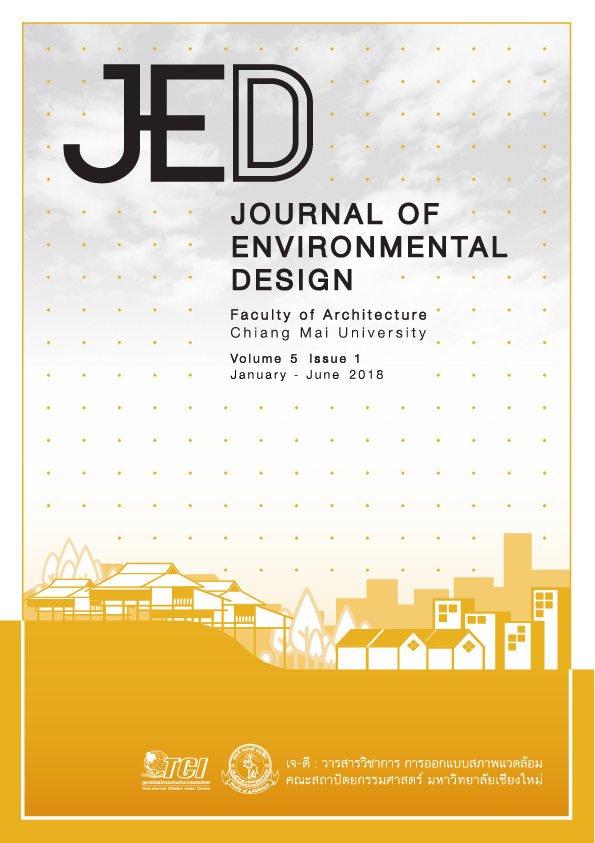การขยายตัวของเมืองกับการเปลี่ยนแปลงบริบทของย่านเมืองเก่าในจังหวัดเชียงใหม่
Main Article Content
บทคัดย่อ
บทความวิจัยนี้มีวัตถุประสงค์เพื่อศึกษารูปแบบสัณฐาน และปัจจัยที่ทำให้เกิดการขยายตัวของเมืองเชียงใหม่เบื้องต้นในมิติเชิงพื้นที่ โดยการประยุกต์ใช้เทคโนโลยีการสำรวจระยะไกลของ Landsat–5 และ Landsat–8 ตั้งแต่ปี พ.ศ.2543–2558 Geo–Informatics and Space Technology Development Agency – GISTDA ซึ่งเป็นช่วงระยะเวลาที่เมืองมีการเปลี่ยนแปลงนโยบาย และแนวทางการพัฒนาเศรษฐกิจหลังจากวิกฤตการณ์ทางการเงินรวมถึงจากรัฐธรรมนูญปี พ.ศ.2540 ทำให้ประชาชนเกิดการมีส่วนร่วมต่อการพัฒนาเมืองและการทำงานของภาครัฐอย่างกว้างขวางมากขึ้น ส่งผลให้สภาพแวดล้อมทางกายภาพของเมืองเชียงใหม่เกิดการเปลี่ยนแปลงหลากหลายรูปแบบ ซึ่งผลจากวิเคราะห์เชิงพื้นที่ โดยการจำแนกเชิงวัตถุ จาก Landsat TM Image Resolution 30 meters, Band 7, 4, 3 ร่วมกับการใช้เครื่องมือเทคโนโลยีสารสนเทศทางภูมิศาสตร์ พบว่า พื้นที่เมืองมีการขยายตัวอย่างชัดเจนใน 3 ช่วงเวลา ได้แก่ ช่วงที่ 1 (พ.ศ.2543–2547) ขยายไปทางทิศตะวันตก ช่วงที่ 2 (พ.ศ.2547–2553) ขยายไปทางทิศเหนือและใต้ และช่วงที่ 3 (พ.ศ.2552–2558) ขยายไปทางทิศตะวันออก จากปัจจัยดึงดูดที่แตกต่างกันไป และจากการสังเกตและการสัมภาษณ์ข้อมูลจากกลุ่มตัวอย่างในพื้นที่ในส่วนศูนย์กลางเมืองเก่าเพิ่มเติม พบข้อมูลที่ชัดเจนว่า ส่วนใหญ่จะเกิดการเปลี่ยนแปลงทั้งรูปแบบการอยู่อาศัย สภาพแวดล้อม และปัจจัยการดำรงชีพของมนุษย์ตามพลวัตของเมืองที่มีการเปลี่ยนผ่านบริบทพื้นที่ศูนย์กลางเมืองเก่าเป็นพื้นที่ย่านเศรษฐกิจเพื่อการท่องเที่ยวโดยปราศจากข้อกำหนดที่เหมาะสมจนกระทั่งผังเมืองรวมเมืองเชียงใหม่ พ.ศ.2555 และกฎหมายเทศบัญญัติเทศบาลนครเชียงใหม่ พ.ศ.2557 ทำให้เกิดการครอบครองการใช้ที่ดิน และการกำหนดขอบเขตเมืองที่ขยายกว้างออกไปอย่างไม่มีขอบเขตที่แน่ชัดทั้งทางกายภาพ สังคม หรือวัฒนธรรม จนกระทั่งส่งผลกระทบถึงการรับรู้บริบทเชิงพื้นที่ของย่านเมืองเก่าที่ค่อยๆ เลือนหาย ทั้งด้านเอกลักษณ์ โครงสร้าง และความหมายของความเป็นล้านนา อันเป็นอุปสรรคสำคัญต่อการอนุรักษ์ศิลปวัฒนธรรม และฟื้นฟูบริบทของย่านเมืองเก่าเชียงใหม่ ตลอดจนการวางนโยบายการพัฒนาที่สอดรับกับบริบทที่หลากหลายของเมืองในปัจจุบันอย่างสมดุล
Article Details
เอกสารอ้างอิง
Charoenmuang, A. (2006). Muang Chiang Mai tee yangyuen neawkid lea prasobkarn khong yan Watket. (In Thai) [Sustainable cities in Chiang Mai: concepts and experiences from Watket District]. Chiang Mai: Social Research Institute, Heinrich Boll Foundation.
Charoenmuang, T. (1997). Khwamrapphitchop tor satharana. (In Thai) [Public accountability]. Bangkok: Kobfai.
Chiang Mai Municipality. (2014). Thetsabanyat thetsabannakorn Chiangmai. (In Thai) [Regulations of Chiang Mai municipality]. Retrieved June 2, 2017, from http://www.dpt.go.th/wan/lawdpt/dta /02/2559/132_33g_100258_1.pdf.
Geo-Informatics and Space Technology Development Agency – GISTDA. (2000). Data of Landsat-5 and Landsat-8 since 2000-2015. Chiang Mai: GISTDA Office.
Horayangkura, V. (2011). Kan sang sapapwadlom chumchon muang tee nayu : panha tee mong mai hen lae naewtang kaekhai. (In Thai) [Creating a living urban environment: unseen problems and possible solutions]. Journal of Architectural/Planning Research and Studies, 8 (2), 9–26.
National Statistical Office Thailand. (2016). Chiang Mai: population and tourist statistics. Retrieved September 11, 2016, from http://www.nso.go.th/
Office of the National Economic and Social Development Board. (2016). The gross domestic product (GDP) Thailand and the gross provincial products (GPP) Chiang Mai 2012. Retrieved September 2, 2016, from https://www.egov.go.th/th/index.php.
Ongsakul, S. (2001). Prawattisat Lanna. (In Thai) [The history of Lanna]. Bangkok: Amarin Printing and Publishing.
Oranratmanee, R. (2014). Muang Chiang Mai: silapa sathapattayakam lae khwamchuea. (In Thai) [Chiang Mai city: arts architectures and beliefs]. Chiang Mai: Lanna Architecture Center, Faculty of Architecture, Chaing Mai University.
Pimonsathean, Y. (2006). Kan prubprung fuenfu lae kan anurak muang. (In Thai) [Urban rehabilitation and conservation]. Bangkok: Thammasat University Press.
Prakasvuthisan, K. (2009). Karn khleunwai khong prachasangkhom nai muang Chiang Mai tor praden panha tee koetkhuen jak khwam pen muang 2540–2551. (In Thai) [Social movements in Chiang Mai against problems from urbanization during 1997–2008]. Journal of Social Sciences, 21 (1), 171–213.
Relph, E. (1976). Place and placelessness. London: Pion.
Roberts, M. (1998). Urban design and regeneration. In Greed, C. & Robert, M. (Eds.). Introducing urban design: intervention and responses (pp.239–245). Singapore: Longman.
Sardsangjun, T. (2013). Karn chamnaek choeng watthu jak khomun phabtaai daotiam THEOS: koranee sueksa nai boriwen changwat Nonthaburi. (In Thai) [An object–based classification using THEOS imagery: case study of Nonthaburi]. Bangkok: Department of Geography, Faculty of Arts, Chulalongkorn University.
Suwatcharapinun, S. (2015). Phab sathon khwam thansamai: thopthuan botbat sathapattayakam samaimai muang Chiang Mai 2517–2518. (In Thai) [Reflection of modernity: re–exploring the role of modern architecture in Chiang Mai (1884–1975)]. Journal of Architectural/Planning Research and Studies, 12 (1), 79–102.
Zielenbach, S. (2000). The art of revitalization: improving conditions in distressed inner–city neighborhoods. New York: Garland Publishing.


